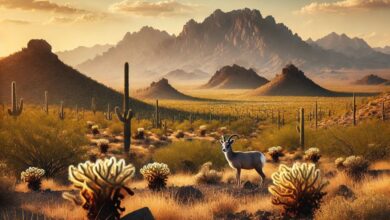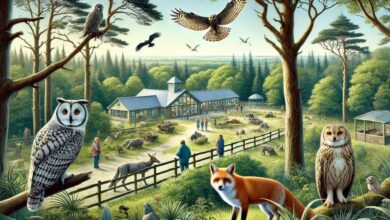Understanding the Grand Dunes National Park Ecosystem: A Natural Marvel

The Grand Dunes National Park, located in southern Colorado, is renowned for its vast and towering sand dunes, the tallest in North America. These sand formations, which can reach up to 750 feet, are part of a unique high-altitude desert landscape that contributes to an extraordinary and diverse ecosystem. However, the park encompasses much more than just sand dunes. Its ecosystem includes a variety of habitats such as grasslands, wetlands, subalpine meadows, montane forests, and alpine tundra, all of which combine to create a rare and dynamic natural environment.
In this article, we will explore the Grand Dunes National Park ecosystem, focusing on the key habitats, wildlife, and plant species that thrive here, as well as the environmental conditions that shape this remarkable park.
The Sand Dunes: A Unique Desert Ecosystem
At the heart of Grand Dunes National Park lies its namesake—the massive sand dunes. These dunes are constantly shifting and reshaping due to wind patterns, making the area a place of continual change. Despite their dry appearance, the dunes hold moisture year-round due to an underground water table. This moisture allows for the survival of specially adapted plant species such as scurfpea and blowout grass, which stabilize the dunes and prevent them from eroding further.
The sand dunes are home to a number of desert-dwelling animals, such as Ord’s kangaroo rat, a small rodent that has adapted to the extreme temperatures. Another unique species found in this ecosystem is the Great Sand Dunes tiger beetle, which scurries across the dunes hunting for prey. This part of the park represents a harsh environment where only the hardiest organisms can survive.
Wetlands and Riparian Zones: Lifeblood of the Ecosystem
Surrounding the dune fields are riparian zones and wetlands, particularly along Medano Creek. These areas are critical to the park’s biodiversity, as they provide essential water sources in an otherwise arid region. The wetlands are a crucial habitat for numerous species, including the Rio Grande cutthroat trout and the endangered Rio Grande sucker, both of which depend on the clean, flowing waters of Medano Creek.
The riparian areas also support diverse vegetation, including cottonwoods, willows, and alder trees, which in turn provide shade and habitat for animals like western tanagers and water shrews. The presence of these riparian zones amidst the arid dunes creates a unique juxtaposition of ecosystems, fostering an exceptional variety of plant and animal life.
Alpine and Subalpine Habitats: A High-Elevation Refuge
As visitors move further from the dunes and ascend into the mountains of the Sangre de Cristo Range, they encounter alpine and subalpine ecosystems. The transition from desert to forest happens gradually, with vegetation becoming denser and more diverse. In the subalpine meadows, wildflowers bloom in mid-summer, creating a vibrant and colorful landscape. These meadows capture heavy snow in winter and retain summer rains, providing moisture for species like bison, elk, and pronghorn.
At higher elevations, subalpine forests give way to alpine tundra, where temperatures drop significantly, and tree growth is limited. Species such as the bristlecone pine and limber pine can be found here, some of which are over a thousand years old. The alpine lakes and tarns that dot this area are also crucial habitats for amphibians and trout, contributing to the park’s rich biodiversity.
Grasslands and Shrublands: Supporting Large Mammals
Encircling the sand dunes on three sides are expansive grasslands and shrublands, which provide a habitat for larger mammals like bison, coyotes, and mule deer. This area, known as the “sand sheet,” transitions from desert shrubland to cool-grass prairies depending on groundwater levels. The grasslands are particularly important for grazing animals like pronghorn and provide a food source for predators such as mountain lions and raptors, which hunt at night.
The diversity of plant life in the grasslands includes hardy species like sagebrush and prairie grass, which are well adapted to the dry, nutrient-poor soil. This area also supports burrowing animals such as kangaroo rats and burrowing owls, which have adapted to the park’s semi-arid conditions.
Wildlife in the Grand Dunes National Park Ecosystem
The Grand Dunes National Park ecosystem is home to a wide variety of wildlife, ranging from the tiniest insects to large mammals. In addition to the previously mentioned species, the park supports reptiles like the wandering garter snake and short-horned lizard, amphibians like the Great Plains toad, and birds such as owls and raptors.
Invertebrates also play a crucial role in the park’s ecosystem. The Great Sand Dunes tiger beetle and painted lady butterfly are just two examples of the many insects that thrive in the park’s diverse habitats. Notable arachnids, such as the black widow spider and tarantula hawk wasp, add to the park’s impressive biodiversity, contributing to the complex web of life in this desert ecosystem.
The park is also home to a number of rare and endangered species. The Uncompahgre fritillary butterfly and American pika, both of which are highly sensitive to climate change, find refuge in the park’s high-altitude environments. The Preble’s meadow jumping mouse, listed as a threatened species, inhabits the riparian zones, where it plays a key role in the local food chain.
Environmental Threats and Conservation Efforts
Despite its pristine appearance, the Grand Dunes National Park ecosystem faces numerous environmental challenges. Climate change poses a significant threat to the park, particularly for species that are highly dependent on specific environmental conditions, such as the American pika. Rising temperatures and changing precipitation patterns could also affect the water levels in Medano Creek, which would have cascading effects on the species that rely on the wetlands.
Human activities, such as tourism and development, can also disrupt the delicate balance of the park’s ecosystems. Efforts are underway to protect the park’s natural resources through conservation initiatives, including habitat restoration and the protection of endangered species. Park management emphasizes the importance of preserving these ecosystems for future generations.
Conclusion: A Remarkable Ecosystem Worth Protecting
The Grand Dunes National Park ecosystem is an extraordinary blend of desert, forest, grassland, and alpine environments, each supporting a wide array of species. From the towering sand dunes that define the park to the riparian zones, wetlands, and high-altitude habitats, this ecosystem is a testament to the resilience and adaptability of life in extreme conditions.
As we continue to explore and appreciate the beauty of this unique ecosystem, it is essential that we take steps to protect it from environmental threats and human impact. By preserving the Grand Dunes National Park ecosystem, we ensure that future generations can experience the wonder and diversity of this exceptional natural landscape.



